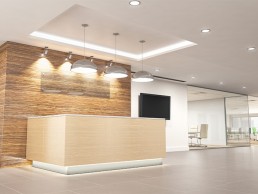
SLL publish specialist lighting guide for FMs
(UK) – SLL Lighting Guide 20 addresses key lighting tasks for facilities managers.
The Society of Light and Lighting (SLL) has published its first guidance document designed specifically to address the key lighting tasks required of facilities managers.
Lighting is a critical element in providing a safe and productive work environment, and much of the management required to procure, maintain and optimise lighting systems falls on facilities managers. The SLL Lighting Guide (LG) 20 sets out a logical approach for non-specialists in lighting to identify and undertake the tasks required in order to “provide the right amount of light in the right place for the right amount of time”.
The guide explains the three critical aspects to meet this objective; firstly, quality of light – lighting levels, uniformity, unified glare rating (UGR) and colour rendering; secondly the quantity of light – watts and lumens, colour temperature and fidelity, useful life expectancy of LED light sources; thirdly is timing and lighting controls.
LG20 also includes guidance on energy consumption and assessing the maintainability of existing lighting installations. This information is often required in relation to service level agreement, or can create a compelling argument for upgrading lighting systems, in terms of investment in energy savings, reduced carbon footprint and increased reliability.
The guide features three case studies, each helping to provide practical examples and context. These look at lighting for a data centre; upgrading emergency lighting in a 6-storey building; and the circular economy and repurposing luminaires. There is a growing interest and need for a circular economy approach, meaning that future lighting installations may be made up of refurbished or even leased products.
Written by Sophie Parry, vice-chair of the SLL Technical and Publications committee, in conjunction with the CIBSE Facilities Management group, LG20 is designed to be supportive of facilities managers with knowledge of electrical services, but whose work may occasionally involve lighting or related decision making.
Regarding the aims of the guide, and in developing communication between related disciplines, Parry said: “As the construction industry aligns with the increasing drive to net zero carbon by 2050, one of the methods being considered to reduce embedded carbon within a building’s fabric is to re-furbish existing buildings where possible, rather than demolish and re-build. The refurbishment scope and complexity will vary on a project by project basis, but in many instances will require local knowledge and input from the incumbent facilities manager. it is therefore imperative that facilities managers have the correct knowledge level/access to knowledge of many construction disciplines to add value to such projects.”
LG20 is the latest addition to a series of application-specific Lighting Guides, produced by CIBSE and the SLL. A full list of publications is available via the SLL website, including the SLL Code for Lighting and the Lighting Handbook.



